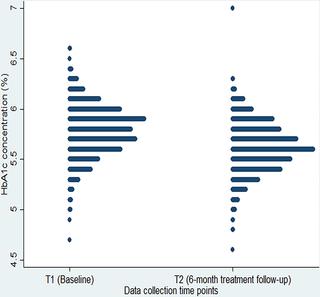PLOS Neglected Tropical Diseases ( IF 3.4 ) Pub Date : 2018-03-15 , DOI: 10.1371/journal.pntd.0006332 Nan Shwe Nwe Htun , Peter Odermatt , Ivan Müller , Peiling Yap , Peter Steinmann , Christian Schindler , Markus Gerber , Rosa Du Randt , Cheryl Walter , Uwe Pühse , Jürg Utzinger , Nicole Probst-Hensch

|
Background
Low- and middle-income countries are facing a dual disease burden with infectious diseases (e.g., gastrointestinal tract infections) and non-communicable diseases (e.g., diabetes) being common. For instance, chronic parasite infections lead to altered immune regulatory networks, anemia, malnutrition, and diarrhea with an associated shift in the gut microbiome. These can all be pathways of potential relevance for insulin resistance and diabetes. The aim of this study was to investigate the association between common gastrointestinal tract infections and glycemia in children from non-fee paying schools in South Africa.
Methodology
We conducted a cross-sectional survey among 9- to 14-year-old school children in Port Elizabeth. Stool and urine samples were collected to assess infection status with parasitic worms (e.g., Ascaris lumbricoides, Enterobius vermicularis, and Trichuris trichiura), intestinal protozoa (e.g., Cryptosporidium parvum and Giardia intestinalis), and the bacterium Helicobacter pylori. Glycated hemoglobin (HbA1c) was measured in finger prick derived capillary blood. All children at schools with a high prevalence of helminth infections and only infected children at the schools with low infection rates were treated with albendazole. The association of anthelmintic treatment with changes in HbA1c 6 months after the drug intervention was also investigated.
Findings
A high prevalence of 71.8% of prediabetes was measured in this group of children, with only 27.8% having HbA1c in the normal range. Helicobacter pylori was the predominant infectious agent and showed an independent positive association with HbA1c in a multivariable regression analysis (β = 0.040, 95% confidence interval (CI) 0.006–0.073, p<0.05). No association of HbA1c with either any other infectious agent or albendazole administration was found.
Conclusion
The role of H. pylori in diabetes needs confirmation in the context of longitudinal treatment interventions. The specific effect of other gastrointestinal tract infections on glycemia remains unclear. Future studies should integrate the measurement of biomarkers, including immunological parameters, to shed light on the potential mediating mechanisms between parasite infections and diabetes.
中文翻译:

南非伊丽莎白港贫困社区小学生胃肠道感染与糖化血红蛋白之间的关系
背景
低收入和中等收入国家面临着双重疾病负担,传染病(例如胃肠道感染)和非传染性疾病(例如糖尿病)很常见。例如,慢性寄生虫感染会导致免疫调节网络改变,贫血,营养不良和腹泻,并伴有肠道微生物组的变化。这些都可能是与胰岛素抵抗和糖尿病潜在相关的途径。这项研究的目的是调查南非非付费学校儿童的常见胃肠道感染与血糖之间的关系。
方法
我们对伊丽莎白港的9至14岁学童进行了横断面调查。收集粪便和尿液样品来评估与寄生虫(例如,感染状态蛔虫,蛲虫,和鞭虫),肠原生动物(例如,隐孢子虫和贾第鞭毛虫肠),以及细菌幽门螺杆菌。在来源于手指刺的毛细血管血中测量了糖化血红蛋白(HbA1c)。在学校所有蠕虫感染率高的儿童中,只有在感染率低的学校中被感染的儿童接受阿苯达唑治疗。还研究了驱虫治疗与药物干预后6个月HbA1c变化的关系。
发现
在这组儿童中,糖尿病前期的患病率很高,为71.8%,只有27.8%的HbA1c在正常范围内。幽门螺杆菌是主要的传染原,在多变量回归分析中显示与HbA1c具有独立的正相关性(β= 0.040,95%置信区间(CI)0.006-0.073,p <0.05)。没有发现HbA1c与任何其他传染原或阿苯达唑的给药相关。
结论
H的作用。糖尿病的幽门螺杆菌需要在纵向治疗干预的背景下得到确认。其他胃肠道感染对血糖的具体作用尚不清楚。未来的研究应整合生物标志物的测量,包括免疫学参数,以阐明寄生虫感染与糖尿病之间的潜在介导机制。











































 京公网安备 11010802027423号
京公网安备 11010802027423号